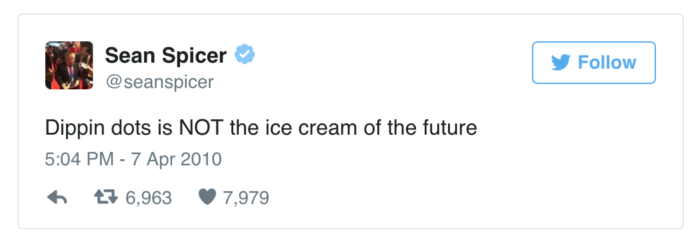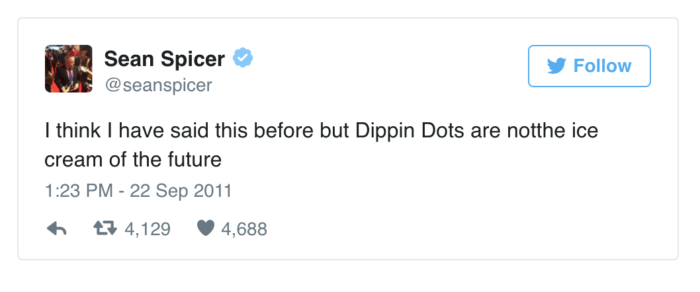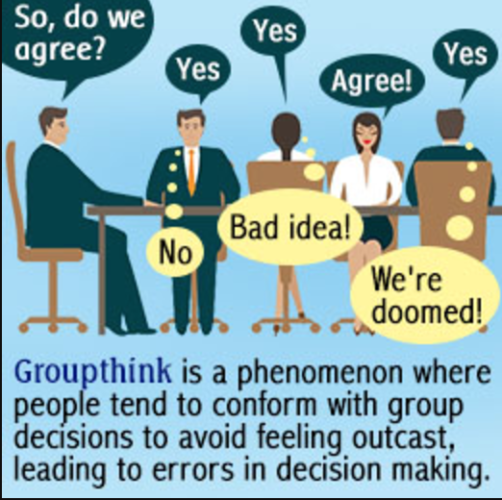Do you ever run out of great ideas? We all do. Try these brainstorming tactics for content creation the next time you’re faced with writer’s block.
1. Consider trends in the media

Dippin’ Dots Ice Cream, recently took advantage of the media attention surrounding White House Press Secretary, Sean Spicer.
Over the years, Spicer has sent out tweets about the ice cream company.



In response to Spicer’s tweets, Dippin’ Dots issued the following open letter:
“Dear Sean,
We understand that ice cream is a serious matter. And running out of your favorite flavor can feel like a national emergency! We’ve seen your tweets and would like to be friends rather than foes. After all, we believe in connecting the dots.
As you may or may not know, Dippin’ Dots are made in Kentucky by hundreds of hard working Americans in the heartland of our great country. As a company, we’re doing great. We’ve enjoyed double-digit growth in sales for the past three years. That means we’re creating jobs and opportunities. We hear that’s on your agenda too.
We can even afford to treat the White House and press corps to an ice cream social. What do you say? We’ll make sure there’s plenty of all your favorite flavors.
Yours,
Scott, CEO of Dippin’ Dots”
Do you know where I learned about this story? PR Daily on my Twitter feed.
Twitter is a great way to stay abreast of trends in the media, but you have to follow the right sources. Here are a few of my favorites. I recommend checking them every morning.
- Associated Press
- New York Times
- Washington Post
SEE ALSO: Using Media Relationships to Build Your Digital Brand
2. Formulate ideas in bulk
Come up with as many two-word idea slugs as you can. A “slug” is a journalistic term for a short name given to an article still in production. As an example, the two-word idea slug for this blog post was “brainstorming-tactics.”

The more two-word slugs you generate the better. They don’t have to be perfect because the ideas that are really good can be fine-tuned later.
3. Record ideas whenever and wherever
“Write down the thoughts of the moment. Those that come unsought for are commonly the most valuable.”
Francis Bacon, Sr.
Jot down your ideas whenever and wherever they come — on the train, in the grocery store, when you wake up in bed, in the shower (get out) — write them down.
I’m assuming everyone reading this has a smartphone. I’m a big fan of the notes app and I recommended it to anyone else caught without pen and paper.

4. Create an outline/ storyboard
Before you start writing, filming, or recording, be sure to provide structure to your content by drawing up a solid outline or storyboard.

Your content can take on a life of its own unless you keep it focused. But if you can nail down an intro and figure out your subheads, you’ll be in good shape.
Brainstorming tactics for groups
It’s often necessary for content teams to collaborate on ideas and the editorial calendar. Group brainstorming tactics differ from those that you would use alone, as you are now working with group dynamics.

The following will cover group brainstorming tactics in more detail.
5. Come up with your own ideas first
This tactic goes back to formulating ideas in bulk — the two-word slugs. Have them ready the next time you meet with your team for a brainstorming session.

Taylor, Berry and Block (2010) found that group participation in brainstorming can inhibit individual creativity. Indeed, people can become so fixated on others’ ideas that they find it impossible to formulate their own.
If everyone in the group comes prepared with their respective lists of two-word slugs then the issue of cognitive fixation should not be a problem.
6. Don’t throw out “bad ideas”
There are no bad ideas when you begin group brainstorming tactics. This famous tip was first suggested by Alex Osborn, the advertising executive who popularized the term “brainstorming” in 1939.
Osborn believed that in the beginning of a group brainstorming session, participants should not criticize ideas, but rather they should try to improve upon them. Criticism is reserved for a later stage in the brainstorming process.

The hope here is that by reserving judgment, participants will let their guards down and produce novel ideas.
SEE ALSO: Your 5 Step Blueprint to Content Marketing Success
7. Avoid groupthink
A group brainstorm is a discussion, not an argument. People get passionate about their ideas. Don’t be so afraid of conflict that you abandon your own ideas for someone else’s.
By that same token, don’t be so aggressive to get your point across that others feel uncomfortable (or even afraid) to voice their opinions and ideas.
Lindred Greer of the Stanford Business School found that if a decision requires creativity, the group should be staffed with members of the same status and that all group members should contribute to the ultimate decision.

Remember, the reason for a group brainstorm is to increase quantity and diversity of ideas. Ask yourself if you truly believe in an idea or if you’re simply agreeing?
8. Practice anonymous alterations
If you suspect groupthink or want to prevent it, as the group moderator, there are things you can do.
First, have everyone write down their ideas on a piece of paper (NO NAMES). Then have them fold the paper and toss it into a hat.

Pass the hat around so that everyone draws someone else’s piece of paper. group members can then take the idea and suggest how they would improve upon it. They then fold the paper and toss it back into the hat.
Repeat this process for as many times as there are group members.
In Conclusion:
By following both the individual and group brainstorming tactics that I’ve laid out in this article, you will see a difference in your content brainstorming efforts.
Are you an expert brainstormer? What other tactics can you share to help improve the quality of content?











